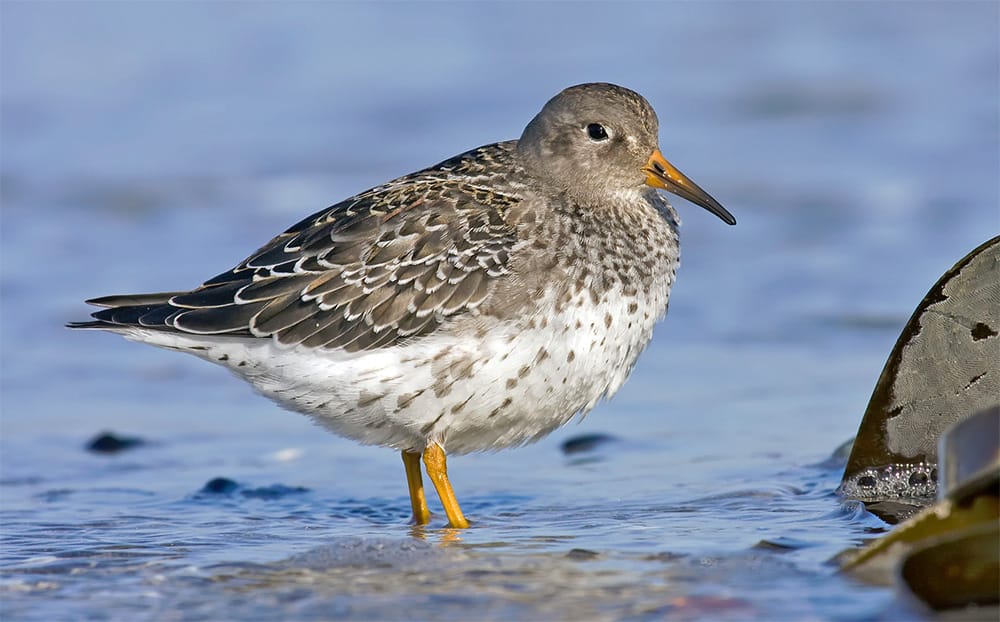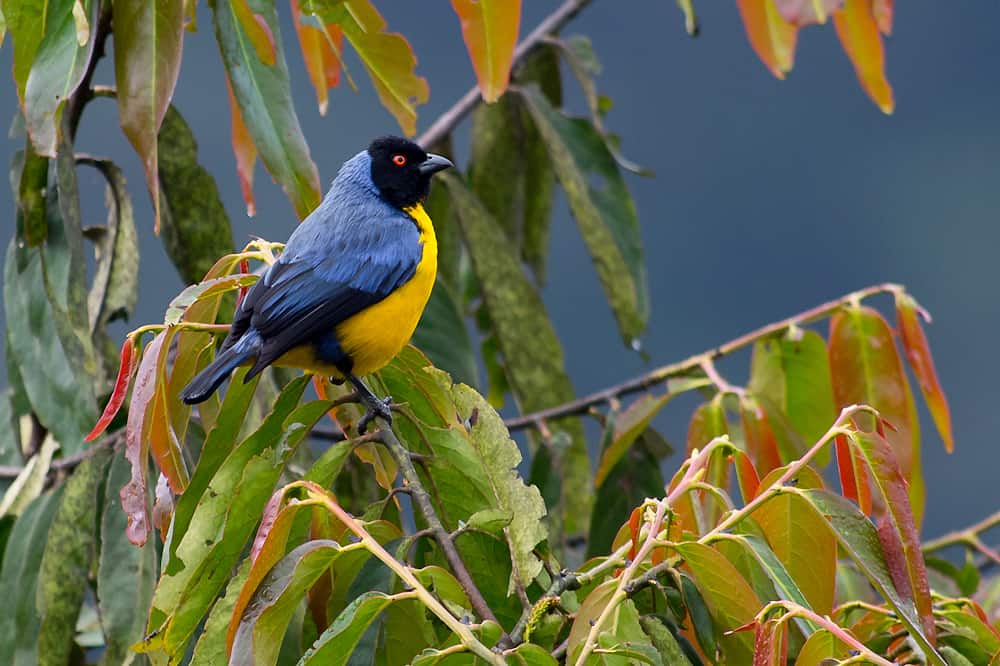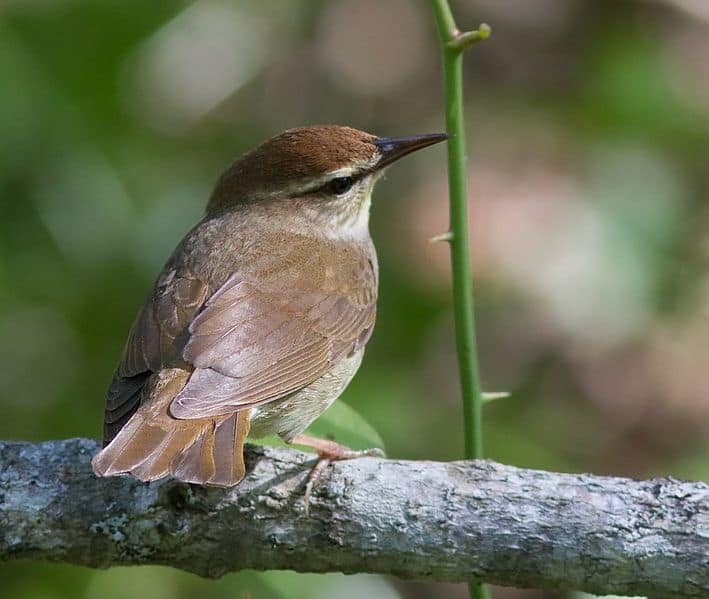For the purpose of describing wildlife habitat, the Wildlife Diversity Program of the Iowa Department of Natural Resources (DNR) divides Iowa into four geographical regions: the Loess Hills, the Prairie Pothole Region, the Heartland, and the Northeast Plateau.
Loess Hills and Missouri River Alluvial Plain
Standing on the bluffs of the Loess Hills, at the western edge of Iowa, you get a spectacular view of the broad Missouri River Valley. The river once meandered in loose curves and braided threads through the alluvial plain, which is up to 12 miles wide. Now the Missouri is restricted to a narrow channel, and the valley is planted with corn and soybeans. Nevertheless, the river valley is still a major flyway for migrating waterfowl. Huge flocks of snow geese can be found at migratory stopovers such as De Soto National Wildlife Refuge, in Harrison County.
Shorebirds, herons, and other water-dependent species also use the valley. Western kingbirds, blue grosbeaks, and Bell’s vireos nest in the bottomlands. Before the river was channelized, least terns and piping plovers bred in the river’s wide sandbars. Small numbers of these two rare species now nest at the MidAmerican Energy power plant, south of Council Bluffs.
During the Ice Ages, the river must have run white as milk with rock pulverized into silt by the grinding of glaciers, and great quantities of the silt was deposited in the flood plain. Wind dried out this fine material, called loess, and lifted it into the air, only to drop much of it immediately east of the river. Over thousands of years, loess from the river accumulated in deepening drifts, which today stand 60 to 200 feet high in a narrow band known as the Loess Hills. Since fire is now suppressed, the prairie that once covered the hills is giving way to trees. Remnants of prairie at Preparation Canyon State Park, in Monona County and other sites in the Loess Hills support nesting grassland species such as northern bobwhites, wild turkeys, and lark sparrows.
In fall, birders flock to the Loess Hills to watch raptors migrate along the river valley, getting a free ride from the updrafts formed when westerly winds strike the sheer face of the cliffs. Turkey vultures, Swainson’s hawks, red-tailed hawks, ospreys, sharp-shinned hawks, and broad-winged hawks are counted in hundreds or thousands, and there’s always a chance of seeing Mississippi kites, northern goshawks, prairie falcons, or golden eagles.
Prairie Pothole Region
In the Des Moines Lobe, where a mile-deep glacier sat on the land 12,000 years ago, the land is generally flat and wet. The thousands of potholes that give the region its name support wetland-dependent animals—turtles, frogs, muskrats, and a wealth of birds.
The glacier left its mark in the form of many natural lakes, such as Storm Lake, Lake Okoboji, Spirit Lake, and Clear Lake. Clustered near the Minnesota border, these “Iowa Great Lakes,” are the heart of a flourishing recreational industry. They also offer some great birding opportunities. Pied-billed grebes, Canada geese, and other waterfowl, Forster’s and black terns, American and least bitterns, northern harriers, bobolinks, yellow-headed blackbirds, and swamp sparrows nest in the region.
More than 95 percent of Iowa’s wetlands have been drained and converted to agriculture. The remaining wetlands, such as Union Slough National Wildlife Refuge, in Kossuth County, and reconstructed prairie marshes such as Dunbar Slough Wildlife Area, in Greene County, provide vital migratory stopovers and nesting habitat for gull and terns, waterfowl, shorebirds, herons, and other water birds. In recent years, the North American Waterfowl Management Plan has restored many wetlands by plugging drainage tiles so that water will pool again in natural depressions.
Another good place to observe Prairie Pothole habitat is Spring Run Wildlife Area, near Spirit Lake, in Dickinson County. Many small, separate marshes offer nesting habitat to American bitterns, blue-winged teal, redheads, rails, and soras. May and June are best for observing nesting marsh birds. In late summer, shorebirds using the area include lesser yellowlegs, least sandpipers, and pectoral sandpipers.
Pilot Knob State Park, in Hancock County, features kettleholes, depressions created by isolated chunks of melting glacier. Overlooking the scenic Winnebago River, the park is home to green herons, wood thrushes, and scarlet tanagers. An observation tower and miles of trails help to make this park inviting to birders.
In the Prairie Pothole region, lush tall-grass prairie covered the upland areas and was home to ground-nesting grassland specialists such as short-eared owls. Nineteenth century observers reported sandhill cranes, whooping cranes, and greater prairie-chickens, species whose populations virtually disappeared with the demise of the prairie ecosystem. At Kalsow Prairie State Preserve’s beautiful tall-grass prairie remnant, in Pocahontas County, sedge wrens nest alongside dickcissels, bobolinks, and upland sandpipers. Although Kalsow has no paths, walking is easy, and in summer, native wildflowers and butterflies abound.
During the era of the glacier, water etched channels under the ice. These channels became the headwaters and beds of Iowa rivers such as the Des Moines, the Raccoon, and the Skunk. Many wooded natural areas along these rivers attract both birds and birders. Boaters have especially good access to birding along these rivers.
Saylorville Reservoir, in Polk County, created by damming the Des Moines River, has made new habitat for huge numbers of birds. It’s a favorite location for watching thousands of American white pelicans in fall, as well as raptors, waterfowl, shorebirds, gulls and terns, herons, loons, and passerines.
The Heartland’s Rolling Plains
Roads rise and fall over the undulating hills of southern Iowa. This is the landscape that Grant Wood painted, a varied topography of towns and rich agricultural fields, of woods, grasslands, rivers, reservoirs, and a few marshes.
Pastures and grassy areas attract species that once depended on the prairie plants of this region. Dickcissels and meadowlarks sing from roadside fences. Occasionally cattle egrets, upland sandpipers, and Brewer’s blackbirds patrol cattle pastures. Along the forest/grassland edge, reintroduced wild turkeys are common again, after being extirpated in the early 20th century.
Most of the state’s woodlands lie along the waterways of southern and eastern Iowa, providing habitat for screech owls, gnatcatchers, and tanagers. Shimek Forest in southeast Iowa’s Lee County is treasured by birders for its worm-eating, Kentucky, blue-winged, hooded, and cerulean warblers. Nesting ruffed grouse probably descend from birds that were released into Shimek Forest beginning in the 1960s, and they have persisted there without expanding their range.
In the separate tracts of Stephen’s State Forest, scattered in five south central Iowa counties, oak-hickory forest, farmland, and prairie fields create a mosaic that provides nesting habitat for Cooper’s hawks and southern Iowa specialties such as whip-poor-wills, white-eyed vireos, blue-winged warblers, and ovenbirds. Thrushes, including veeries, also occur in the forest, as well as a good assortment of migrating warblers. Much of the forest is available by road, and several miles of hiking trails offer additional access. Birders have recently discovered chuck-will’s-widows near Lake Rathbun, in Appanoose County.
Although southern Iowa is not richly endowed with natural wetlands, some areas get generous shorebird and waterfowl migration traffic. In Riverton Wildlife Area, in Fremont County, snow geese congregate by the thousands in late February or early March on their way north. Shorebirds also use the region in spring, especially in April and May, if the water levels are low enough to let the birds wade and feed in the mud. This is one of the best places in the state to see Hudsonian godwits, Baird’s sandpipers, and Wilson’s phalaropes. Herons and egrets can be found on the mudflats in late summer.
Another fine wetland in the southern Iowa Heartland region is Cone Marsh Wildlife Area, in Louisa County, where more than 250 bird species have been recorded, including American woodcock, prothonotary warbler, and yellow-headed blackbird. From the parking lot, walk on the main dike to get into the middle of the marsh, where you can observe grebes, waterfowl, sedge wrens, and, if you’re lucky, rails. Sandhill cranes have shown up here in recent years, as well as cinnamon teal, tundra swans, and almost any bird that likes water.
There’s good birding in Iowa cities, towns, and farms, too. The mature trees of small towns attract rose-breasted grosbeaks and great horned owls. Red-winged blackbirds nest among the cattails of farm ponds and roadside ditches, while barn swallows swoop to their nests on the rafters of open barns.
Northeast Plateau—the Little Switzerland of Iowa
Camped at Yellow River State Forest, in Allamakee County, you follow a hiking trail through the woods on a May morning. In the distance, perhaps from across a steep ravine, you hear a male ruffed grouse as he stands on a log and pumps his wings. The low-pitched drumming he makes sounds as if it’s coming from inside your own chest. Once found throughout Iowa, ruffed grouse have declined and disappeared from most of the state, due to heavy hunting pressures and loss of habitat. However, in the heavily forested and rugged northeastern corner of the state, the species resides year-around. Other specialized woodland birds, such as pileated woodpecker, prothonotary warbler, and broad-winged hawk, breed here as well.
Compared with most of Iowa’s gentle rolling landscape, the northeastern corner looks utterly different. It’s often called Little Switzerland, because of its deep, narrow valleys, waterfalls, rapids, and rugged rock bluffs. In this scenic terrain, ancient Paleozoic bedrock lies near the surface, without the layers of sand, clay, gravel, and boulders deposited by glaciers over most of the state. The Mississippi River has dug deep into this hard terrain. Its flow is bordered by sheer cliff faces, along which hawks, ospreys, and eagles migrate. It’s not necessary to get up early to watch them, as they start flying only in mid morning, when they can conserve energy by use the thermals that rise from the sun-heated cliffs.
The region is rich in springs, sinkholes, deep caverns, and life forms not found elsewhere in Iowa. Certain north-facing cliffs harbor underground ice that remains almost all summer long, offering sanctuary to plants and animals such as the northern monkshood and the Iowa Pleistocene land snail. Cold streams are home to brook trout that survive naturally without stocking.
Other characteristic birds of the region are great blue heron, wood duck, bald eagle, red-shouldered hawk, ruby-throated hummingbird, ovenbird, American redstart, and yellow warbler. At Pool #9 of the Mississippi River, in Allamakee County, enormous numbers of waterfowl congregate in fall and early winter, including thousands of tundra swans. Golden eagles winter along the Mississippi’s tributary rivers and streams.
Good places to bird in the Northwest Plateau are White Pine Hollow in Dubuque County, Pike’s Peak State Park in Clayton County, and Yellow River Forest and Effigy Mounds National Monument in Allamakee County.




